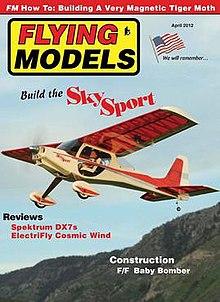A vertical take-off and landing (VTOL) aircraft is one that can take off and land vertically without relying on a runway. This classification can include a variety of types of aircraft including helicopters as well as thrust-vectoring fixed-wing aircraft and other hybrid aircraft with powered rotors such as cyclogyros/cyclocopters and gyrodynes.

A model aircraft is a physical model of an existing or imagined aircraft, and is built typically for display, research, or amusement. Model aircraft are divided into two basic groups: flying and non-flying. Non-flying models are also termed static, display, or shelf models.
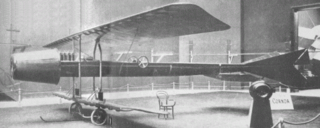
The Coandă-1910, designed by Romanian inventor Henri Coandă, was an unconventional sesquiplane aircraft powered by a ducted fan. Called the "turbo-propulseur" by Coandă, its experimental engine consisted of a conventional piston engine driving a multi-bladed centrifugal blower which exhausted into a duct. The unusual aircraft attracted attention at the Second International Aeronautical Exhibition in Paris in October 1910, being the only exhibit without a propeller, but the aircraft was not displayed afterwards, and it fell from public awareness. Coandă used a similar turbo-propulseur to drive a snow sledge, but he did not develop it further for aircraft.

Control line is a simple and light way of controlling a flying model aircraft. The aircraft is connected to the operator by a pair of lines, attached to a handle, that work the elevator of the model. This allows the model to be controlled in the pitch axis. It is constrained to fly on the surface of a hemisphere by the control lines.
This is a list of aviation-related events from 1905:

Peter M. Bowers was an aeronautical engineer, airplane designer, and a journalist and historian specializing in the field of aviation.

Railroad Model Craftsman is an American magazine specializing in the hobby of model railroading. The magazine is published monthly by White River Productions, which acquired the title from Carstens Publications in 2014. Its first issue in March 1933 was called The Model Craftsman because it covered other areas of scale modeling as well. Founded by Emanuele Stieri, it was second editor Charles A. Penn who helped grow the company and lead the publication towards the hobby of scale models. In April 1949 it changed its focus to model trains and changed its name to Railroad Model Craftsman to reflect this change in editorial content. While it can claim to be the oldest model railroading magazine in continuous publication in the United States, rival Model Railroader counters with the tagline "Model railroading exclusively since 1934." Over the years, several other titles have been folded into the publication, including Toy Trains, Electric Trains and Hobby Railroading, Miniature Rail Roading, Model & Railway News, and The O Gager.

The Ace Baby Ace, a single-seat, single-engine, parasol wing, fixed-gear light airplane, was marketed as a homebuilt aircraft when its plans were first offered for sale in 1929 — one of the first homebuilt aircraft plans available in the United States. Plans are still available and Baby Aces are still being built. Orland Corben designed a series of aircraft for the Ace Aircraft Manufacturing Company, the Baby Ace, Junior Ace, and Super Ace. Corben's name was associated with the aircraft, and it is commonly known as the Corben Baby Ace.
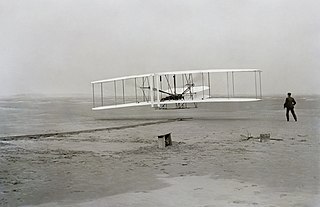
In aeronautical and naval engineering, pusher configuration is the term used to describe a drivetrain of air- or watercraft with its propulsion device(s) after its engine(s). This is in contrast to the more conventional tractor configuration, which places them in front.
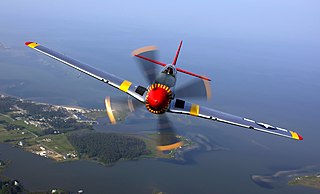
An airplane or aeroplane, informally plane, is a fixed-wing aircraft that is propelled forward by thrust from a jet engine, propeller, or rocket engine. Airplanes come in a variety of sizes, shapes, and wing configurations. The broad spectrum of uses for airplanes includes recreation, transportation of goods and people, military, and research. Worldwide, commercial aviation transports more than four billion passengers annually on airliners and transports more than 200 billion tonne-kilometers of cargo annually, which is less than 1% of the world's cargo movement. Most airplanes are flown by a pilot on board the aircraft, but some are designed to be remotely or computer-controlled such as drones.

A radio-controlled aircraft is a small flying machine that is radio controlled by an operator on the ground using a hand-held radio transmitter. The transmitter continuously communicates with a receiver within the craft that sends signals to servomechanisms (servos) which move the control surfaces based on the position of joysticks on the transmitter. The control surfaces, in turn, directly affect the orientation of the plane.

A miniature UAV, small UAV (SUAV), or drone is an unmanned aerial vehicle small enough to be man-portable. Smallest UAVs are called micro air vehicle.

Paul K. Guillow, Inc., commonly known as Guillow's, is an American manufacturer of balsa wood model aircraft kits.
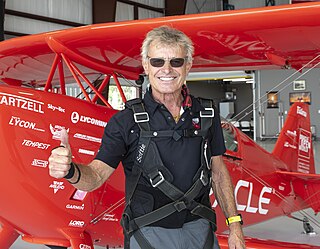
Sean Doherty Tucker is an American world champion aerobatic aviator. He was previously sponsored by the Oracle Corporation for many years, performing in air shows worldwide as "Team Oracle". Tucker has won numerous air show championship competitions throughout his career, was named one of the 25 "Living Legends of Flight" by the Smithsonian's National Air and Space Museum in 2003, and was inducted into the National Aviation Hall of Fame in 2008. He has led several efforts to assist youth in learning to fly or becoming involved in general aviation, and currently serves as co-chairman of the Experimental Aircraft Association (EAA)'s Young Eagles program, a role he has held since 2013.
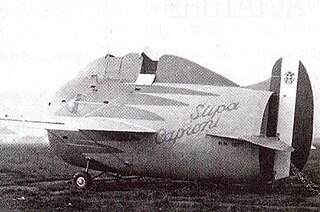
The Stipa-Caproni, also known as the Caproni Stipa, was an experimental Italian aircraft designed in 1932 by Luigi Stipa (1900–1992) and built by Caproni. It featured a hollow, barrel-shaped fuselage with the engine and propeller completely enclosed by the fuselage—in essence, the whole fuselage was a single ducted fan. Although the Regia Aeronautica was not interested in pursuing development of the Stipa-Caproni, its design influenced the development of jet propulsion.

A monocopter or gyropter is a rotorcraft that uses a single rotating blade. The concept is similar to the whirling helicopter seeds that fall from some trees. The name gyropter is sometimes applied to monocopters in which the entire aircraft rotates about its center of mass as it flies. The name "monocopter" has also been applied to the personal jet pack constructed by Andreas Petzoldt.
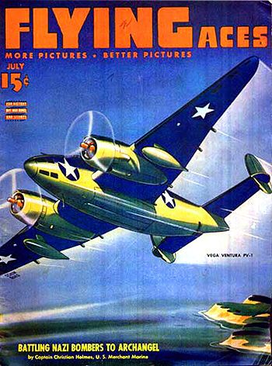
Flying Aces was a monthly American periodical of short stories about aviation, one of a number of so-called "flying pulp" magazines popular during the 1920s and 1930s. Like other pulp magazines, it was a collection of adventure stories, originally printed on coarse, pulpy paper but later moved to a slick format. The magazine was launched in October 1928 by Periodical House, Inc. It featured stories written and illustrated by known authors of the day, often set against the background of World War I. Later issues added non-fiction aviation articles, as well as articles and plans for model airplanes. The latter became more prominent, and eventually the magazine was renamed Flying Models, and catered exclusively to aeromodeling hobbyists.

Wings Across America 2008 (WAA-08) was a group of model airplane enthusiasts that flew a battery-powered radio-controlled aircraft (RC), designated as a park flyer, in all 48 contiguous United States with hopes to make all 50, if Alaska and Hawaii could be reached. A park flyer is a small radio-controlled plane typically flown in a field such as a local park or soccer field.
Carstens Publications, Inc. was a publisher of books and magazines related to the railroad and airplane hobby fields until its permanent closure on August 22, 2014. Many of the titles published by Carstens were older than the company, and have long established histories in their respective markets. Carstens was the chief competitor to Kalmbach Publishing in the scale model hobby and enthusiast field. What made Carstens stand out from the competition was the in-depth detail and active voice of the books and magazines. The company's list of monthly magazine titles included:

Railfan & Railroad is an American monthly magazine that has been in publication since the 1970s. It was the first magazine title established in-house by Carstens Publications. As a magazine dedicated to trains and rail transportation, it stands out from its main competitor Trains as a publication focused on the enthusiast and related activities. Established in 1974 as Railfan magazine, it merged in 1979 with Railroad magazine, which Carstens purchased at that time. The magazine was renamed Railfan & Railroad, but the two former titles were listed separately on the masthead until 2015. The magazine was acquired by White River Productions in September 2014. The magazine is produced monthly, edited by Steve Barry.
